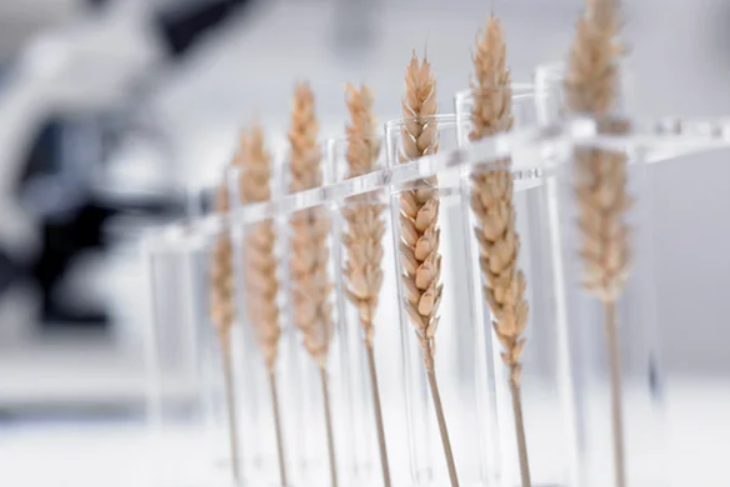With new gene-editing techniques, the controversial technology will no longer be necessary

As a scientist who has spent his career in agricultural biotech, I’ve watched with some sympathy as the public struggles to sort out whether to embrace innovation in agriculture or continue a wariness that originated nearly 40 years ago with the introduction of genetically modified crops.
Very recently the agricultural world watched with interest as the European Union’s highest court upheld a decade-old policy that hinders innovation in farming. I have listened carefully to the concerns and understand a certain degree of trepidation about introducing new technologies to farming practices that are thousands of years old. But we are out of time to fix a changing climate and shrinking arable land. The world’s population is growing by 80 million every year, Europe is dealing with yet another “hottest summer on record” and parts of the U.S. have experienced wildfires daily for two years.
It is clear to me agriculture needs to adapt. The only question is how can we move forward in a way that does not repeat the mistakes of the GMO (genetically modified organism) era? The answer lies in newer technologies that allow us to responsibly develop crops that never integrate non-native elements into a plant. This was the catastrophic mistake of GMO. Today’s science is very different and enables us to precisely target and direct a plant’s natural gene-editing process. This approach accelerates natural breeding that has been a staple of farming for thousands of years and is already proving to be a rapid, versatile and low-cost way to improve nutrition, increase crop yields and reduce waste.
But to understand how this technology differs from GMO it helps to have some context. One problem is the terminology: genetic modification. In a basic sense all crop breeding since the dawn of agriculture has involved genetic modification of organisms. When the ancient tribes of the Balsas River Valley in south central Mexico first began to try and enhance the yields of teosinte some 10,000 years ago, they didn’t know it but they were trying to alter the genetic makeup of this grass. It is only through accumulated changes in genes that teosinte was domesticated to become corn. Whereas changing genes in humans or animals raises ethical concerns, it’s important to keep in mind this has been the goal in agriculture since the dawn of civilization.
Through most of history these gene edits were accomplished via trial and error. Plant breeders would find desirable traits in their crops and optimize them over many years through cross-breeding. Scientists cannot improve the amount of material a plant can produce through photosynthesis—that limit is imposed by external factors such as sunlight, nutrients, water and weather. Breeders, however, can alter a plant’s priorities, so to speak—shifting biomass from roots to seeds, for instance. Thus, in the 1950s when Norman Borlaug bred a dwarf wheat with a stalk sturdy enough to support a heavy head of seeds, the green revolution was born, and India was blessed with a way of feeding its exploding population.
By the 1980s, green revolution techniques had spread widely around the developing world, and the agricultural community wondered what innovation could power the next big jump in yields needed to feed the world’s ever-growing population. In 1994 agribusiness giant Monsanto offered a partial answer when it introduced Roundup Ready soybeans and corn. Farmers flocked to these crops because they could use them in conjunction with Monsanto’s herbicide, which killed weeds that competed with crops for sunlight, water and nutrients. Regulators in many countries, including the U.S., deemed the product safe but the public continued to be concerned because such crops are transgenic, meaning that they have been created by the transfer of genetic material from unrelated living organisms.
Despite 25 years of widespread use, public resistance to such transgenic crops has only grown, and this has limited enthusiasm for the further spread of GMO. This posed a dilemma. Agriculture needed a new engine to boost yields, but the public had no appetite for the further deployment of GMO.
Enter precision gene editing, an entirely new approach to plant breeding that is radically different from what we know as GMO. Forty years ago scientists resorted to inserting foreign genetic material because in the 1970s no one knew how to precisely change particular genes associated with a specific trait. In other words, transgenic technology (GMO) was a kind of stopgap, used in the absence to tools to achieve what plant breeders have always wanted to accomplish: to make a particular change and obtain a particular result.
Since that time the picture has changed dramatically: Geneticists have developed an ever-more sophisticated understanding of the interactions of various genes in plants. Meanwhile molecular biologists have developed various types of genetic scissors to knock out particular parts of DNA and devised other means of effecting tiny changes. And with gene editing, all of these changes occur solely within the genome of a particular plant, meaning no non-native material is integrated.
It’s difficult to overstate the importance of this new revolution in plant breeding. It makes the debate over transgenic GMOs moot because, as it was put in Nature, precision gene editing produces changes “indistinguishable” from how genes change in a natural setting. Regulators in the U.S., Canada and a host of other countries in Europe, South America and Asia have studied these tools and certified they are as harmless as traditional plant breeding.
In essence, plant breeding has come full circle. Scientists can now develop new crops the way nature would do it given enough time, but gene editing allows these changes to be made at warp speed. Drought- and disease-resistant crops are now possible, in addition to those that increase yields for farmers as well as taste and nutrition for consumers. What might take thousands of years through the stately pace of evolution can now be achieved in a matter of months. Given the ever-increasing stresses on the global food system, precision gene editing could not have arrived at a more fortuitous time.











RSS